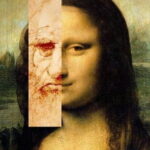To assume that Leonardo da Vinci’s Last Supper contains the secrets of the universe, in any form, is to dishonour this great artist severely. Leonardo da Vinci, often held to be the foremost figure of the Renaissance period, was a jobbing artist who worked within the constraints of his time, yet made astounding leaps in form, method and thinking. The astounding elements of his great work The Last Supper are not hidden in secret codes, but exactly what you see before you.
The first extraordinary thing about the painting is that it still exists in any form at all. Unlike almost any other famous artwork, The Last Supper has been hacked up, bombed, vandalised and painted over – and all this for a piece that was using an experimental technique in the first place.
adparams.getadspec(‘c_billboard1’);
The painting, which resides at the convent of Santa Maria delle Grazie, was painted between 1496 and 1498, when da Vinci was in the midst of his competitive years as artist-for-hire. The painting was created with a new technique using pigment placed directly on the wall, rather than the traditional fresco method of tinted plaster. The latter method would possibly have been a better choice, as the experimental technique needed frequent repairs over time. It is these repairs that have added to the confusing mix of clues and misinterpretations of detail in the picture.
Much of the recent interest in the painting has centred on the details hidden within the painting, but in directing attention to these ‘hidden’ details, most people miss the incredible sense of perspective the work displays. The sharp angling of the walls within the picture, which lead back to the seemingly distant back wall of the room and the windows that show the hills and sky beyond. The type of day shown through these windows adds to the feeling of serenity that rests in the centre of the piece, around the figure of Christ.
The perspective used in the piece draws the eye naturally to Christ before you take in the chaos around him. Christ sits placidly in the centre of his table, as his disciples talk and debate with each other around him. Technically, the craft used to continually draw the eye in toward Christ is an excellent use of one point perspective.
The subject of the painting is not at all remarkable for its time – or even for Leonardo’s body of works. Spending his apprenticeship as a jobbing artisan, doing commissioned pieces depicting angels and other biblical figures, Leonardo fit with the artists of his time in painting what was pleasing to his patrons. Many others attempted to depict the last meal Christ shared with his followers, but the difference in Leonardo’s work was the way he chose to engage the subject, creating a realistic snapshot of a ‘family’ meal, showing Christ’s disciples as human, animated entities.
The depiction of such a realistic meal was a doubly clever choice given the setting for the piece. For centuries, faithful visitors to the convent had the painting to whet their appetite as they sat for their evening meal. Even now, gazing on the interactions depicted in the scene makes me hanker after a communal meal, so much so that I can almost smell the nice crunchy bread on the table.
The beauty of The Last Supper is in its simple humanity, which is depicted with the skill that was Leonardo’s genius. Like many of his works, the piece contains a mixture of the methods of his day and inspired innovation, and the result is much to be admired.

